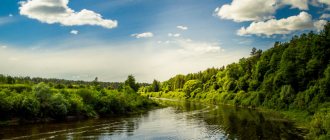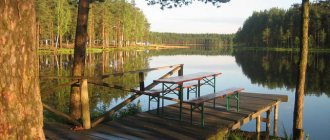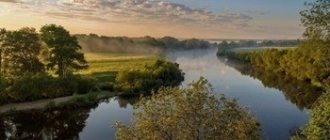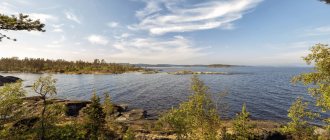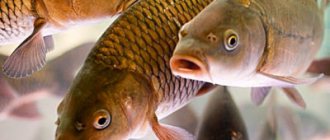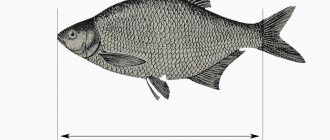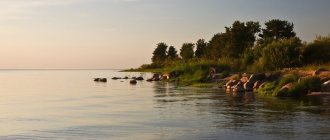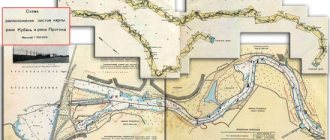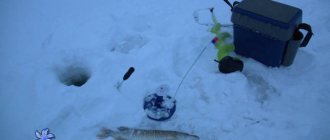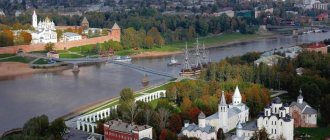Detailed map of rivers in the Moscow region
Due to certain circumstances, fishermen often have to look for new places for fishing. Doing this is not as easy as it seems at first glance. Come and wind many kilometers along the coast in search of promising fishing spots. And this task often takes more than one day. That is, the fisherman, instead of fishing, spends his time looking for a place.
Topographic maps can make it easier for an angler to find fishing spots. This material contains an interactive fishing topographic map of the rivers of Moscow and the Moscow region. Topographic maps will allow you to navigate the area, find the optimal path to a reservoir, identify landmarks, find promising fishing spots and much more.
An interactive topographic map of the rivers of Moscow and the Moscow region will allow you to obtain the most accurate information about the reservoir and directions to it. A special feature of the map is that you can change its scale at your discretion. The map shows all the largest rivers of Moscow and the Moscow region. A complete list of reservoirs indicated on the map is located in the form of a list under the map itself. An interactive topographic map of reservoirs is available for viewing online on our fishing portal absolutely free.
In addition, if you are interested in other reservoirs of this region in addition to the rivers of Moscow and the Moscow region, you can familiarize yourself with the material “Fishing topographic maps of Moscow and the Moscow region.” This material contains three types of fishing topographic maps of Moscow and the Moscow region: a map of scale 1:750000, a map of scale 1:1000000 (kilometre: 1 kilometer in one centimeter) and an interactive topographic map of reservoirs of Moscow and the Moscow region. All these maps are available for downloading and viewing online absolutely free of charge, without registration and without SMS.
Enjoy watching and happy fishing!
Fishing satellite map of Moscow and the Moscow region watch online
Due to certain circumstances, fishermen often have to look for new places for fishing. Doing this is not as easy as it seems at first glance. Come and wind many kilometers along the coast in search of promising fishing spots. And this task often takes more than one day. That is, the fisherman, instead of fishing, spends his time searching for a place.
Satellite maps can make it easier for fishermen to find fishing spots. This material contains an interactive fishing satellite map of water bodies in Moscow and the Moscow region. Satellite maps will allow you to navigate the area, find the optimal path to a body of water, identify landmarks, find promising fishing spots and much more.
The peculiarity of satellite maps is their accuracy and interactivity. In fact, a satellite map is a set of photographs taken from a satellite. And because these photographs are taken at high resolution, satellite maps provide fantastic detail and accuracy of information. And if we add interactivity to this, that is, it is possible to zoom in and out of the map image, the possibilities of such maps are simply unlimited. Many fishermen have already begun to use satellite maps to search and explore promising fishing spots. We invite you to start using this excellent tool for the modern fisherman.
An interactive satellite map of reservoirs in Moscow and the Moscow region will allow you to obtain the most accurate information about the reservoir and directions to it. A special feature of the map is that you can change its scale at your discretion. The map shows all the largest rivers, lakes, reservoirs and canals of Moscow and the Moscow region. A complete list of reservoirs indicated on the map is located in the form of a list under the map itself. An interactive satellite map of reservoirs is available for viewing online on our fishing portal absolutely free.
Enjoy watching and happy fishing!
Interactive topographic map of the rivers of Moscow and the Moscow region watch online:
Scale: variable.
Rivers of Moscow and the Moscow region marked on the map:
- Moskva river;
- Oka River;
- Volga river;
- Klyazma River;
- Ruza River;
- Nara River;
- Yauza River;
- Dubna River;
- Sister River;
- Sturgeon River;
- Protva River.
If you liked this material, please recommend it to your friends on social services using the social sharing buttons. When copying material to other sites, a link to our site as the source is required! Even online you can and should remain polite people. In order to follow updates on our site and the appearance of new interesting materials on it, we advise you to register or simply subscribe to updates by e-mail or RSS. We are glad to see you on our information and entertainment portal about fishing and everything connected with it megaribolov.ru! Thank you for your attention!
You do not have sufficient rights to write comments. Please register on the Portal or log into your account.
Source
Navigation and economic use of rivers in the Moscow region
The Moscow River, 502 km long, includes another 362 rivers (tributaries). Its navigation begins from the peak of spring until late autumn. There are several beaches on the river.
The Volga, one of the largest rivers in Eastern Europe, is also considered a navigable river. But it does not flow completely through the Moscow region, sometimes it is not even included in the list of large rivers in Moscow.
The region's rivers are used for swimming, recreation for tourists and residents, sports, and for drinking water supply. Due to the high level of agriculture, recreational activities, industry, and household activities, the water resources of the area have become shallow.
On the banks of rivers there are nature reserves and natural monuments that are actively protected. An example of this is the Yazvenka River (a small river only 5 km away) with the Tsaritsyno Nature Reserve.
For fishing lovers there are also several tasty places, for example Voblya, Vyazemka, Oka.
Black Lake
This reservoir arose on the site of a deep quarry, and clean water is its calling card. The lake has wonderful scenery, so fishing can be a great activity for families with children. The smell of a coniferous forest and the chirping of local birds will allow you to take your mind off routine everyday life, and the bite of crucian carp and rotan will make fishing more fulfilling.
How to get there:
By car:
Along the Shchelkovskoe or Yaroslavskoe highway, exiting onto the Fryanovskoe highway, a little over an hour on the road from Moscow. The lake is located 38 kilometers from the Moscow Ring Road near the intersection of the A107 highway and the Fryanovskoe highway.
By public transport:
From the Shchelkovskaya metro station by bus 335K (Moscow-Fryanovo) to the Betonka stop (39 stops), approximately 1:30 hours on the way. Then cross the A107 highway for 500 meters (about 8 minutes on foot from the stop).
Coordinates:
56.040902, 38.204376 (click on the coordinates to open the location on the maps)
Interactive satellite map of lakes in Moscow and the Moscow region watch online:
Scale: variable.
Lakes and ponds of Moscow and the Moscow region marked on the map:
- Lake Aplatovo;
- Lake Baboshkino;
- Lake Bezdonnoe (Lake Forest Park);
- Lake Beloye (Kosinsky Three Lakes);
- Lake Biserovo;
- Lake Bolshoye Sokolovo;
- Lake Velikoye (Shatura Lakes);
- Lake Glubokoe (Shatura Lakes);
- Lake Glubokoe (Ruzsky district);
- Lake Dolgoye (Myshetsk lake group);
- Lake Dolgoye (Shatura Lakes);
- Lake Dilevo (Lake Forest Park);
- Lake Dubovoe (Klepikovskaya system of lakes);
- Lake Imles (Klepikovskaya system of lakes);
- Lake Karasovo (Shatura Lakes);
- Lake Kiyovo;
- Lake Krugloye (Myshetskaya lake group);
- Lake Krugloye (Lotoshinsky district);
- Lake Likharevo (Klepikovskaya system of lakes);
- Lake Lukovo;
- Lake Maryino;
- Lake Mazurinskoye (Lake Forest Park);
- Lake Muromskoe (Shatura Lakes);
- Lake Nerskoye (Myshetsk lake group);
- Lake Pavlenskoe;
- Lake Panino;
- Lake Poletskoe;
- Lake Senezh;
- Lake Svinoshnoye (Shatura lakes);
- Lake Svyatoe (upper) (Klepikovskaya system of lakes);
- Lake Svyatoe (lower) (Klepikovskaya system of lakes);
- Lake Svyatoe (Shatura Lakes);
- Lake Svyatoe (Kosinsky Three Lakes);
- Lake Torbeevskoe;
- Lake Trostenskoye;
- Lake Black (Kosinsky Three Lakes);
- Lake Yushino (Lake Forest Park);
- Bezmenovsky quarry;
- Bear Lakes;
- Nara Ponds;
- Tsaritsyn Ponds.
Lake Biserevo
Experienced fishermen often visit this reservoir, as it is rich in a variety of prey. Fans of predators can try their hand at fishing for striped robber or pike, and for lovers of peaceful fishing, cupid, carp and crucian carp, and bighead carp will be excellent prey. Biserevo is a picturesque lake with shallow depth. The vast territory occupied by the reservoir will provide accommodation for a large number of vacationers. The bottom is usually muddy, but the southern coast has sand.
How to get there:
By car:
Along the Enthusiasts Highway (hereinafter referred to as Gorkovskoye Highway), or Nosovikhinskoye Highway to Biserevskoye Highway, about 30 minutes on the road from Moscow. The lake is located 22 km from the Moscow Ring Road, next to Biserevskoye Highway.
By public transport:
From Kursky station by train to Kupavna station (48 minutes on the way), then either 2 km on foot, or after 1 stop by bus 37, or minibus 29, 57 to the “Cafe” stop, from the stop just cross the road to the lake.
Coordinates:
55.766177, 38.116377 (click on the coordinates to open the location on the maps)
Online Map
One of the most popular recreational activities for men is fishing. They are ready to sit for hours on the shore of a reservoir with a fishing rod in hand, waiting for a bite and catch and enjoying the peace and tranquility.
There are also many Muscovites who love this type of recreation. However, if outside of Moscow you can find a huge number of reservoirs for fishing, then in the capital things are a little different. Finding a good fishing spot to go fishing with pleasure is not so much. But they exist, and you can see them on the map of Moscow fishing spots .
1. In the Maryino area, near Porechnaya Street there are good places for quiet and peaceful fishing. The fishing rod usually catches bream, roach, bleak and large crucian carp.
2. Brateevsky Bridge. Fishing lovers will be able to enjoy a relaxing holiday in the lap of nature and go fishing. The most common catches are roach, bleak, rotan and perch.
3. Stroginsky Bridge will also be a good option for having a good time with a fishing rod in your hands. Fishing here is more suitable for those who enjoy the process itself rather than strive for a big catch. For the most part, bleak and roach are caught on the hook.
4. Novodevichy Pond. Located on Novodevichy Proezd. The fish bite here is weak, but the result, although not serious, is still there. The main fish are roach, rudd, bream and crucian carp.
5. “Fishing in Uzkoy.” This fishing spot is located in Bitsevsky Park. Here you can catch carp, trout, crucian carp, catfish, pike and silver carp. The cost of a day visit is 1600 rubles. After completing your fishing, you can pick up two kilograms of trout or eight kilograms of carp. If you weigh more, you can pay extra - each kilogram - 150-350 rubles.
6. Strogino or Big Quarry on Tamanskaya Street. Fishermen will have a great time, be well rested and be able to hook perch, bleak or roach.
7. Khimki Reservoir. Despite the large crowd of fishermen, luck still smiles on most lovers of such a calm and quiet holiday. The most common fish caught on the bait are pike, crucian carp, goby, perch and sometimes even catfish.
8. “Fishing Paradise” is a paid reservoir where you have to pay two thousand rubles for fishing. At the end of the day, the fisherman can take home nine kilograms of carp and five kilograms of trout. The excess will cost the fisherman 200-300 rubles per kilogram.
9. Timiryazevsky ponds are also a paid leisure activity for fishermen. They are located on Pryanishnikov Street. Here you can catch pike, carp, carp, trout, sturgeon and sterlet. The cost of fishing is two thousand rubles. At the end of the event, the fisherman takes seven kilograms of catfish or pike, ten kilograms of carp, five kilograms of trout and three kilograms of sterlet or sturgeon for this price.
10. Malaya Bronnaya Street is a great place for a quiet, relaxing and peaceful holiday. The catch here cannot be called large and serious. But the process itself will undoubtedly bring pleasure and lift your spirits.
Map of fishing spots in Moscow: biting places
Molokcha River
You will have to get to the river by car, going towards Makhra through the village of Karabanovo. In the summer you can catch silver bream, roach and pike from the shore, and in the fall it makes sense to come hunting for burbot. Fishing from a boat is made difficult by the presence of obstructions of branches and snags. However, near the shores it is too shallow for float fishing. The water in Molokcha is often cloudy, especially in summer, when the water area begins to bloom. Along the banks of the reservoir there is a dense forest, and on the southern side there is a small swamp.
How to get there:
By car:
Take the Yaroslavskoye Highway to the A-108 highway, turn onto it towards Dmitrov, get there, turn towards Strunino at the traffic light, drive along Shosseynaya Street and turn towards the village of Lizunovo, then drive along the road to the village of Perematkino. The distance from Mkada is 94 km and an hour and a half on the road.
By public transport:
It will not be very easy to get to the river by public transport, but if you still decide, the easiest way will be to get from the Yaroslavsky railway station to the Strunino station (2 hours on the way), then it is best to take a taxi and point in the direction towards the river, or village of Perematkino. The taxi ride takes about 20 minutes.
Coordinates:
56.291923, 38.571790 (click on the coordinates to open the location on the maps)
Pakhra River
Muddy water with riffles, in which asp, ide and chub are found, attracts anglers from all over the region. It is best to stop at widenings, as well as gentle turns of the river. You can get there by heading towards the village of Novlenskoye. Many anglers park their vehicles right next to the dam, but fishing is prohibited in this area. Above the dam there is a deeper water area with sandy shores and a calm flow of water. After passing the dam, large stones begin to lie in shallow water. It is in this turbulent stream that the white predator often bites.
Pond Vasyunino
The clean water area with shores free of vegetation and numerous approaches to the water attracts lovers of catching peaceful and predatory inhabitants of the ichthyofauna. There are summer cottages around the lake, so local fishermen compete with visiting vacationers. In many articles, this place is mistakenly called “Vasyutino pond,” which is a misconception, since Vasyutino is located in a completely different direction.
How to get there:
By car:
Along the Warsaw highway, passing Podolsk, we go to the sign for the village of Vasyunino, turn and almost immediately find ourselves in a village with a pond. From the Moscow Ring Road the drive is about an hour and 68 km.
By public transport:
The easiest way to get there by public transport is from the Teply Stan metro station. Take bus 503 and go to the stop “Povorot na Vasyunino” (1:40 hours on the way, 62 stops), then you need to walk about 2 km.
Coordinates:
55.241048, 37.009540 (click on the coordinates to open the location on the maps)
Lykovsky Pond
If you want privacy, then you should leave Vasyunino and drive a few more kilometers. Moving through the field along a dirt road, another body of water looms before the eye. Unsociability and pristine nature are what is so necessary for a modern person who has chosen to take a break from the concrete jungle. The reservoir is surrounded on almost all sides by forest and only on one side by meadow. The water area is rich in carp fish species, as well as predators. Fishermen often visit Lykovsky Pond with a spinning rod, tempting perch and pike to bite.
How to get there:
By car:
The pond is located 2 km from Vasyunino in the village of Lykovka. Travel time increases by only 10 minutes
By public transport:
You can repeat the route to the “Turn on Vasyunino” stop, but then you will have to walk about 6 km. Therefore, if you want to get to the pond without a car, then it is better to get from the Teply Stan metro station on minibus 887 to Voronovo station (a little over an hour on the road, 42 stops), and from there call a taxi to the village of Lykovka (about 20 minutes drive)
Coordinates:
55.248028, 36.972808 (click on the coordinates to open the location on the maps)
Bear Lakes
If you want to fish from a boat, then Bear Lakes is your best choice. You can get to them either by your own transport or by bus, heading along Shchelkovskoye Highway. There is a private farm on a large lake, so fishing here is paid. However, you can fish in a nearby reservoir without paying any money. There you can catch crucian carp, roach, and on spinning rods – perch and pike. They fish on the lake both with spinning rods and with live bait. Among the usual prey there is also an eel, which will be a real crown of the fishing day. Fishing from the shore is not the best idea, since the lake is surrounded by a dense wall of reeds, and there are few approaches to the water.
How to get there:
By car:
Bear Lakes are located 12 km from Moscow along the Shchelkovskoye Highway. You need to get to the village “Bear Lakes”, the time in Pui will be 22 minutes.
By public transport:
From the Shchelkovskaya metro station by bus (320, 321, 335k, 349, 361, 371, 378, 380, 429 - 11 stops), or by minibus 485k to the Medvezhye Ozera stop, the travel time will be 27-30 minutes. From the stop you will immediately see the lakes; you can walk to them in 5-15 minutes.
Coordinates:
55.864334, 37.997368 (click on the coordinates to open the location on the maps)
Holy Lake
The main feature of this reservoir is its non-freezing water surface. Fans of fishing with summer gear can enjoy their favorite activity all year round. The lake is quite deep, so there is a minimal amount of vegetation in its waters. Bream, crucian carp, pike perch and pike are not the only representatives of this water area. A vast water area with an area of 1200 hectares is surrounded by trees, as well as industrial complexes, which slightly spoils the overall landscape. This place is not suitable for those who like fishing alone, far from civilization, but fans of fishing from a boat can always use the services of rental companies who rent out boats right on the shore of the lake.
How to get there:
By car:
The lake is located 2.5 km from the Moscow Ring Road along the Novoukhtomskoye Highway, exit onto Kosinskoye Highway and after a Shell gas station (nearby is the Dmitrievskogo Street metro station), turn left onto Saltykovskaya Street and drive to Kosinsky Park. (An alternative option is to turn from Novoukhtomskoye Highway onto Bolshaya Kosinskaya Street, passing Kosinskoye Highway, or go straight to Kosinskoye Highway)
By public transport:
Due to the opening of the metro in the summer of 2021, getting to the place has become very easy. Get to the Ulitsa Dmitrievskogo metro station and walk towards Kosinsky Park (about 800 m and 11 minutes).
Coordinates:
55.715170, 37.868984 (click on the coordinates to open the location on the maps)
Murom Lake
Not far from the previous fishing spot is the Muromsky reservoir. It is known to experienced fishermen for its abundance of peaceful fish. Today's catches include bream, roach, carp and even ide. Nature is not much different from the landscapes on Holy Lake. The same trees and the top of the local power plant are visible to the eye. Vacationers are often found along the shores, so you should choose a place for fishing away from noisy companies.
How to get there:
By car:
The lake is located in Shatura, about 130 km from the Moscow Ring Road. From the Moscow Ring Road you need to turn onto Lermontovsky Prospekt, then you need to turn onto Yegoryevskoye Shosse (towards Yegoryevsk, the sign will point directly to Zhukovsky). Then, before reaching Yegoryevsk, turn towards Antsiferovo (the sign will indicate that it is 33 km to Yegoryevsk). Passing Antsiferovo we will get onto the A-108 highway, turn right and go to the Shatura highway (there will be a sign for Shatura), pass Shatura and continue driving along the highway after the railway crossing there will be a left turn into the forest (with a large banner “Save the forest!”) . Then we follow this road to the lake. Travel time will be about 2.5-3 hours.
By public transport:
The easiest way is to get from the Kazansky railway station to the Shatura or Botino stop (about 2.5 hours on the road). From Shatura you can call a taxi (the journey is 10 km, 25 minutes, but after entering the forest the road will not be paved), or from Botino station you can walk 2.7 km (about a half-hour walk).
Coordinates:
55.572255, 39.585898 (click on the coordinates to open the location on the maps)
Map of the Moscow river network
Legend
The natural hydrographic network of the city of Moscow has about 1000 individual elements, including temporary watercourses and very small streams (according to some literature data, from 800 to 1300). The presence of rugged terrain and a dense, highly branched river network gave exceptional picturesqueness to the city and its surroundings, and also guaranteed protection from prolonged flooding. With the development of the city, the relief underwent changes, which led to changes in the structure and morphometry of the drainage basins. Great damage was caused to valley and floodplain biocenoses, as well as to hydrobiocenoses of the water bodies themselves.
But the greatest damage to ecosystems was caused as a result of the creation in the city of a complete separate drainage system, which predetermined the use of a natural hydraulic network for the removal and discharge of surface and drainage runoff. Intensive urban development of the territory and the impossibility of practically ensuring the fulfillment of sanitary and environmental requirements for water quality in water bodies (since pollution from the city territory is washed away with surface water) led to the use of the practice of sewerage of elements of the hydrographic network with its gradual transformation into an engineering one.
Today, 134 of the largest watercourses can be identified in the city, of which only 39 have completely open channels, and, therefore, a preserved natural complex to one degree or another. Of these 39 watercourses, 16 are the largest, more than 2 km long, which are the most valuable ecological and landscape-recreational potential of the city.
About 60 rivers have partially open channels with many islands. The natural communities of these rivers are largely disturbed. The remaining rivers have four stages of technogenic transformation: the channel is completely closed (filled up or canalized), the natural complex is lost. However, many of the surviving water bodies and adjacent territories continue to remain unique natural objects, a decoration of the city, its ecological framework and recreational potential that is not fully claimed.
Types of watercourses (rivers and streams) in Moscow
Watercourses are open over more than 90% of their length.
manual
Aleshin r. Alyoshinka r. Bannaya ditch r. Banka r. Bitsa stream Brattsevsky (R. Bratovka) stream. Burtsevsky district Vorobyovka district Gvozdyanka stream Golovinsky (ponds) r. Goretovka r. Grachevka (Butakovsky Bay) stream. Devkin r. Zhuravenka (Popov ravine) r. Ichka r. State district Klyazma r. Cow's enemy Kotlyakovsky district Kuznetsovka district Likova stream Lipitinsky Likhoborsky canal r. Elk r. Elk R. Muravka stream Nikolsky (Nikolsky ravine) Nikolskaya ditch r. Pekhorka r. Setun r. Setunka r. Skhodnya stream Teply Stan stream. Kharigozinsky district Khimka district Gypsy b. Chechera r. Chechera-3 (Southern Butovo) r. Yazvenka (Tsaritsynsky stream) r. Yauza r. Moscow Watercourses are open at 50%-90% of their length.
manual
Baryshikha stream Biryulevsky district Bolshaya Gnilusha r. Budaika r. Dropsy r. Gorodnya r. Gorodyanka (Pushkin ravine) Dubininskaya river r. Kamenka stream Kolomensky (Golosov ravine) r. Kotlovka r. Korshunikha stream Kukrinsky (Troparevsky) stream. Kuskovsky district Likhoborka stream Lianozovsky district Natoshenka (Naverashka) r. Ochakovka r. Rudnevka district Serebryanka stream Troekurovsky district Chernushka r. Chermyanka stream Cherny (Terletsky ponds) r. Chertanovka r. Shmelevka stream Serebryany Bor r. Rzhavka Watercourses are open at 10%-50% of their length.
R.
Bibirevka (Olshanka) stream. Bogatyrsky stream. Botanical r. Businka R. Zhabenka stream Kalitnikovsky (Khokhlovsky) stream. Karacharovsky) stream. Kosinsky district Mullein stream Krylatsky district Beggar b. Noskovska stream. Oleniy Creek Ostankino stream. Perovsky district Palintovka r. Ponomarka (Churilikha) stream. Putyaevsky district Ramenka r. Rogachevka district Samorodinka R. Tarakanova R. Khapilovka (Sosenka) r. Chura R. Yasenevo creek Bath stream Elevatorny (Cherepishka) Lost and underground watercourses
of the creek. Aksininsky stream. Beskudnikovsky (Rzhavets) stream. Bogorodsky district Bubna Obgonny Collector of Borisovsky Pond stream. Cotton factory (Steklyanka river) stream. Vladykinsky stream. Vysokovsky stream Golyanovsky stream. Danilovsky stream. Deguninsky stream. Ermakovsky district Zhuzha (Collector of Kolomensky Stream) r. Zhukova (Leatherworker's enemy) b. Golden Horn stream. Izyutinsky stream Kerosene river Boiling water stream Kozeevsky district Kopan r. Kopytovka district Kuzminsky district Mitino stream. Medvedkovsky (Leonovsky) stream. Naprudny r. Neglinnaya r. Olkhovets r. Olkhovka district Podon r. Presnya r. Rachka r. Rybinka r. Sarah b. Sinichka stream Sobolevsky stream. Studenets-Vagankovsky district Strogino district Tushino Yuzhnoye (Gorodenka) creek. Ugreshsky district Filka manual Fraser b. Khodynka r. Chartera (Chartory) r. Black Mud
White Lake
The free reservoir is located above the local thermal power plant. Bottom fishing methods are popular there: feeder and cast. Carp often sit on the hook, so you need to arm yourself with powerful tackle. Fine groundbait will attract small roaches, so when fishing for carp it is worth using a mixture of broken peas, corn and other relatively large particles. Sloping banks with a hard bottom make it possible to place a large amount of gear. White Lake is perfect for both amateur fishing and a family picnic.
Moscow Canal
A long canal connects two reservoirs. Along the bank of the canal you can find countless promising places where perch, silver bream, bream, as well as other types of fish that are popular in the Moscow region bite. A feeder or match is perfect for fishing, since the edge, as a rule, is located away from the shore. The best results were shown by animal types of baits, such as maggots, bloodworms and red worms. There are large stones on the bank of the canal, and the average depth of the water area is 4-5 meters. Running water quickly carries away a light load, so experienced fishermen use a lead weight of 80 grams or more. And if you love airplanes, you can also take a ride to the Sheremetyevo glide path, which is a 15-minute drive away (glide path coordinates - 55.979001, 37.453913). Where you can see planes landing from the very first row.
How to get there:
By car:
From the Moscow Ring Road, turn onto Leningradskoe Shosse, then follow towards Sheremetyevo Airport (turning onto Mezhdunarodnoye Shosse). Right in front of the airport, turn onto Sheremetyevskoye Highway, driving along it after the Lukoil gas station, turn right, driving straight towards the Bereg residential complex. When you reach the junction near the Bereg residential complex, you need to turn left towards Ivakino. On the right side you will already be able to see the Canal named after them. Moscow. From the Moscow Ring Road the distance is 17 km and 26 minutes drive. Since the Leningradskoye Highway has been heavily loaded and jammed lately, there are 2 alternative routes: a toll road to St. Petersburg and through the Dmitrovskoye Highway (turn onto the New Highway towards Sheremetyev Airport, then you get to the Sheremetyevskoye Highway (also a Lukoil gas station, only now on the right side) turn left.
By public transport:
From Leningradsky station you get to Khimki station (22 minutes travel time). Next, take bus 11 or 17 and get to the “Magazin” stop (14 stops and 22 minutes on the way). Then walk about 800 meters to the Moscow Canal.
Coordinates:
55.957336, 37.484516 (click on the coordinates to open the location on the maps)
Interactive satellite map of reservoirs in Moscow and the Moscow region watch online:
Scale: variable.
Reservoirs of Moscow and the Moscow region marked on the map:
Rivers of Moscow and the Moscow region marked on the map:
Main material : “Satellite map of the rivers of Moscow and the Moscow region.”
- Moskva river;
- Oka River;
- Volga river;
- Klyazma River;
- Ruza River.
Lakes and ponds of Moscow and the Moscow region marked on the map:
Main material : “Satellite map of lakes in Moscow and the Moscow region.”
- Lake Aplatovo;
- Bottomless Lake;
- Lake Biserovo;
- Lake Bolshoye Sokolovo;
- Great Lake;
- Lake Glubokoe;
- Lake Dolgoye (Dmitrovsky district);
- Lake Dolgoye (Shatura district);
- Lake Dubovoe (Klepikovskaya system of lakes);
- Lake Imles (Klepikovskaya system of lakes);
- Lake Krugloye (Dmitrovsky district);
- Lake Likharevo (Klepikovskaya system of lakes);
- Lake Nerskoye;
- Lake Pavlenskoe;
- Lake Poletskoe;
- Lake Senezh;
- Lake Svyatoe (upper) (Klepikovskaya system of lakes);
- Lake Svyatoe (lower) (Klepikovskaya system of lakes);
- Lake Svyatoye (Shatura district);
- Lake Torbeevskoe;
- Lake Trostenskoye;
- Nara Ponds;
- Tsaritsyn Ponds.
Reservoirs of Moscow and the Moscow region marked on the map:
Main material : “Satellite map of reservoirs in Moscow and the Moscow region.”
- Verkhneruzskoye Reservoir;
- Ivankovskoye Reservoir;
- Ikshinskoye Reservoir;
- Istra Reservoir;
- Klyazma Reservoir;
- Mozhaisk Reservoir;
- Ozerninskoye Reservoir;
- Pestovskoye Reservoir;
- Pirogovskoye Reservoir;
- Pyalovskoye Reservoir;
- Ruza Reservoir;
- Uchinskoye (Uglichskoye) reservoir;
- Khimki Reservoir;
- Shalakhovskoye Reservoir;
- Yakhromskoye Reservoir.
Canals of Moscow and the Moscow region marked on the map:
Main material : “Satellite map of channels in Moscow and the Moscow region.”
- Moscow Canal.
Moscow River in Ramensky district
An excellent place for fishing in winter, when the river drops to its lowest level, exposing the banks on which you can comfortably sit with both bottom gear and easily travel many kilometers with a spinning rod in search of the coveted pike perch and pike.
In summer, the water is at its maximum level, but you can still find quite a few places in the Sofiino area and even more in Bronnitsy and below. But don’t forget the main thing: you can go out on a boat at this time, and of course remember the spawning ban.
How to get there:
By car:
From the Moscow Ring Road you turn onto Novoryazanskoye Highway and drive along it towards the working village of Oktyabrsky. When you see a sign indicating a right turn towards Volodarskoye village and Neftebaza, get ready to turn right onto Ryazanskoye Highway. Driving along the Ryazanskoe highway, turn left when you see a sign for Durnikha and drive over the Novoryazanskoe highway. Arriving in Durnikha, do not turn off the main road and reach the village of Vertyachevo. You're at the place.
By public transport:
From the Kotelniki metro station, take a minibus and go to the village of Durnukhi and the Durnikha stop, 58A (24 stops, 45 minutes on the way). Next you will have to walk 3.5 km towards the village of Vertyachevo.
Coordinates:
55.547575, 38.143700 (click on the coordinates to open the location on the maps)
Map of lakes and rivers in the Moscow region
Due to certain circumstances, fishermen often have to look for new places for fishing. Doing this is not as easy as it seems at first glance. Come and wind many kilometers along the coast in search of promising fishing spots. And this task often takes more than one day. That is, the fisherman, instead of fishing, spends his time searching for a place.
Satellite maps can make it easier for fishermen to find fishing spots. This material contains an interactive fishing satellite map of lakes in Moscow and the Moscow region. Satellite maps will allow you to navigate the area, find the optimal path to a body of water, identify landmarks, find promising fishing spots and much more.
The peculiarity of satellite maps is their accuracy and interactivity. In fact, a satellite map is a set of photographs taken from a satellite. And because these photographs are taken at high resolution, satellite maps provide fantastic detail and accuracy of information. And if we add interactivity to this, that is, it is possible to zoom in and out of the map image, the possibilities of such maps are simply unlimited. Many fishermen have already begun to use satellite maps to search and explore promising fishing spots. We invite you to start using this excellent tool for the modern fisherman.
An interactive satellite map of lakes in Moscow and the Moscow region will allow you to obtain the most accurate information about the reservoir and directions to it. A special feature of the map is that you can change its scale at your discretion. The map shows all the largest lakes in Moscow and the Moscow region. A complete list of reservoirs indicated on the map is located in the form of a list under the map itself. An interactive satellite map of reservoirs is available for viewing online on our fishing portal absolutely free.
In addition, if you are interested in other reservoirs of this region in addition to the lakes of Moscow and the Moscow region, you can familiarize yourself with the material “Fishing satellite map of Moscow and the Moscow region.” This material contains an interactive satellite map of reservoirs in Moscow and the Moscow region, on which all the largest reservoirs in this region are marked. This map is available for viewing online absolutely free of charge, without registration and without SMS.
Enjoy watching and happy fishing!
Ivankovskoye Reservoir - Volga River
A relatively close place from Moscow for fishing in a wonderful place near the city of Dubna.
Heading along the Dmitrovskoye Highway towards the reservoir, on your left you will see the Moscow Canal, which in turn is fraught with many surprises and will also serve as an excellent place for fishing before reaching the main place. In the summer season, a huge number of bottom tackle lovers settle down along the canal in the hope of catching trophy bream and other peaceful inhabitants of the local reservoir, the artery of which flows into the Volga.
If you follow your cherished goal, reaching the reservoir, then one of the most popular places for feeder fishing is the peninsula, which you can get to by driving through the “Dubna Bridge” and then turning left in the direction of Dmitrovskoye Shosse, passing the underground tunnel and a little straight ahead, you you will run into a huge area of cubic meters of water, the main landmark of which on the left side will be the monument to V.I. Lenin. Here you will find a truly inspiring place to do what you love.
Fans of spinning rods can enjoy this place with an abundance of asp, pike perch, bersh and pike, but only with the use of a long coastal jig, capable of sending bait 70 meters from the shore. But the best option in this place for spinning anglers would be a “boat”, because... a wide water area will fully reveal itself only at great depth.
Source
Rivers and lakes of the Moscow region
The last glaciation, which ended about 10-12 thousand years ago, formed the river network of the Moscow region : more than two thousand large and small rivers, numerous glacial lakes, gradually turning into swamps.
♦ On the topic: One-day excursions from Moscow: cities, estates, temples and monasteries
Valley of the Uchi River in Fedoskino
The rivers of the Moscow region belong to two basins: Volzhsky and Oksky . The watershed between them runs along the Smolensk-Moscow Upland and the Klinsko-Dmitrovskaya ridge .
The Volga flows in the very north of the Moscow region, on the border with the Tver region . There, near the city of Dubna , the Moscow Canal begins , connecting the Moscow River with the Volga. The largest tributaries of the Volga within the boundaries of the Moscow region are the Dubna and Sestra . They originate on the northern slopes of the Klinsko-Dmitrovskaya ridge; in the upper reaches they flow in deep valleys, often without terraces. In some places there are rapids and rifts. When reaching the Upper Volga Lowland, the current becomes calmer.
In the south of the region flows the Oka , a tributary of the Volga (which flows into the latter near Nizhny Novgorod ). Here lies the border between the Moscow, Kaluga and Tula regions. The Oka flows freely through a wide terraced valley, its banks are sometimes steep, and landslides occur. Oka is also a natural border between two natural zones. To the north of it, mixed forests grow; to the south, in the ravines and ravines of the Central Russian Upland, remnants of once numerous broad-leaved forests have been preserved.
Another important river in the Moscow region is the Moskva River . It originates near the village of Starkovo in the Mozhaisk region, and near the city of Kolomna it flows into the Oka. For a long time, the Moscow River was characterized by inconsistent flow, sometimes almost drying up, and sometimes sweeping away everything in its path. Now the water level in the Moscow River is regulated: the riverbed has been straightened, a system of reservoirs and locks has been built, and the flow of Volga water is ensured through the Moscow Canal.
Moscow River and Moscow Kremlin
In the west and south of the region flow the main tributaries of the Moscow River: Ruza, Ozerna, Istra, Pakhra, Koloch . Sloping and soft banks give way to steep and steep ones, and among the low hills the rivers form wide bends.
The largest tributaries of the Oka are the Nara, Klyazma, and Lopasnya .
The Tsna, Nerskaya, and Yalma rivers flow through the Meshcherskaya lowland . Their shores are often muddy and marshy, and the water has a reddish tint due to iron impurities.
Another river in the Moscow region, but this time man-made, is the Moscow Canal , the length of which reaches 128 km. Dmitlag prisoners in 1932-1937. Thanks to the canal, Volga water began to flow into the Moscow River, and the problem of water supply to the capital was solved. Moscow became a port of five seas, gaining access to the Baltic, White, Caspian, Azov and Black seas. In place of lowlands, swamps, rivers and streams, picturesque reservoirs were formed: Ikshinskoye, Pestovskoye, Pyalovskoye, Klyazminskoye, Khimkinskoye . Currently, they have become popular recreation areas for Muscovites and residents of the Moscow region. Boarding houses, holiday homes, yacht clubs, sports and fitness centers, etc. have been built here. Unfortunately, the shores are being actively built up with elite cottage villages, almost blocking access to the water.
At the Ikshinskoye Reservoir
Among the numerous lakes in the Moscow region, the largest is Senezhskoye , which is located near the city of Solnechnogorsk . It is of artificial origin. Its area is 15.4 sq. km.
Entire “constellations” of lakes have formed in the Meshcherskaya Lowland The largest are located near Shatura (Lake Svyatoe) and near the village of Cherusti (Lake Velikoye and Dolgoe).
Want to know more about China? I write about this in my telegram channel “Middle Way”
© Website “On the Roads of the Middle Way”, 2009-2021. Copying and reprinting of any materials and photographs from the site anashina.com in electronic publications and printed publications is prohibited.
Online services that help me travel:
- Cheap flights: Aviasales
- Hotels and recreation centers: Booking
- Travel insurance: Cherehapa
- Excursions in Russian: Tripster and Sputnik8
View all
Rivers of the Moscow region on the map
About 2 thousand rivers and streams flow through the Moscow region, so the region is considered to be quite densely covered with water resources. Among these rivers, only 400 have a length that exceeds 10 km. Hydrographers classify the waters of all these rivers as belonging to the basins of the four largest rivers in the region. This is, first of all, the Volga in the north of the region, the Oka in the south, and Moscow and Klyazma in the center.
Thus, the north of the region where the Upper Volga Lowland is located is penetrated by tributaries of the Volga, which include the Yakhroma, Lamoy, Sestra, Dubnaya and Shosha rivers. In the south of the region is the Oka with its tributaries, including the Nara, Lopasney and Protvoy. Moreover, among all the rivers of the Moscow region, the Oka is the largest. Scientists also attribute some of the tributaries of the Moscow River to the Oka basin, along their entire length. The east and northeast of the region are occupied by tributaries of the Klyazma, which originates on the Moscow Upland and flows into the Oka. Almost all the waters of these rivers are located in the Meshchera Lowland. A cadastral map of land plots in the region by district can be found here. The Moscow River is a kind of axis of the region’s water resources. Its waters are located almost in the center of the region. The river stretches for 502 km, and the total area covered by its waters is 17,640 km².
Middle rivers of the Moscow region
Dubna River
Dubna is a tributary of the Volga, it stretches for 167 km. The river is quite actively used for farming, which leads to severe “poisoning” with waste. There are also fishing and hiking routes on Dubna.
Nara River
The river, 158 km long, spreads across two regions, Kaluga and Moscow. The Nara flows into the Oka, being its tributary. The main attraction of the river is its ponds, which tourists often admire.
Ruza River
A tributary of the Moscow River, 145 km long. There are two main reservoirs on the river - Ruzskoye and Verkhneruzskoye. The main pride is the Nezhdin settlement.
Lama River
The river “passes” in two regions - Moscow and Tver. The river carries its waters for 139 km. The Zavidovo Nature Reserve is located on the bank of the river. The main attractions are the ancient estates.
Sister River
The sister is one of the “sleeves” of Dubna, 138 km long. The river with a twisty bed flows through flat terrain. There is a reservoir on Sestra. Fishing is developed.
Pakhra River
This river completely spreads over the territory of the capital and its region for 135 km. Dams have been erected along the entire length. The river is very polluted, which is why fish have been suffering lately.
Istra River
The 113-kilometer Istra is one of the branches of the Moscow River. A reservoir was built on the river. The main places on the banks are two monasteries, as well as more than 50 recreation centers.
Vorya River
A tributary of the Klyazma, 108 km long. The main attraction is the Abramtsevo Estate Museum. There are very picturesque places here that famous cultural figures loved to visit.
Lopasnya River
A tributary of the Oka, 108 km long. There are several dams on the river. Lopasnya is endowed with 36 tributaries.
Tsna River
The hundred-kilometer Tsna is one of the tributaries of the Oka. There is a reservoir and dams on the river. Tsna attracts tourists and fishermen.
